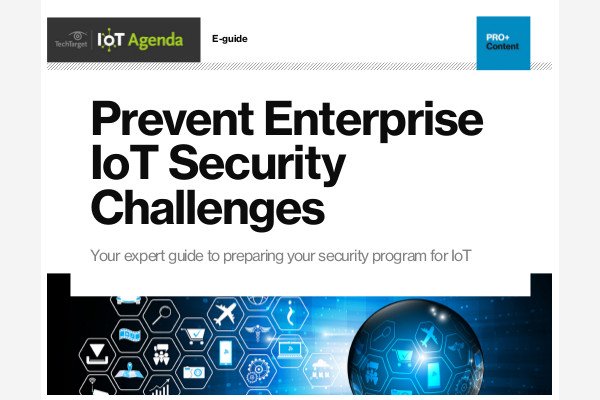Why IoT needs startup studios
The idea of startup studios is becoming more popular, and with good reason. There are fundamental repeatable processes that can equate to substantial leverage when creating a startup from within a studio. And the idea that the internet of things is a significant and broad advance of technology in our world is no longer up for debate. It’s not a fad; it’s real and here to stay. That said, we still see mountains of IoT pilot projects and far, far fewer production IoT examples, much less ones that are fully integrated and compliant with the organization’s larger information technology architecture. By looking a little deeper into why the startup studio model is gaining steam, and why the broader IoT market is struggling in moving from pilots to production, we can spot a correlation that re-enforces the idea of the studio model for IoT.



Download Our Guide and Overcome IoT Security Challenges
The IoT is imminent – and so are the security challenges it will inevitably bring. Get up to speed on IoT security basics and learn how to devise your own IoT security strategy in our new e-guide.
By submitting your personal information, you agree that TechTarget and its partners may contact you regarding relevant content, products and special offers.
You also agree that your personal information may be transferred and processed in the United States, and that you have read and agree to the Terms of Use and the Privacy Policy.
Aren’t studios like WeWork?
Let’s start with a basic definition of a studio. Many people conflate the idea of a “tech incubator,” of which there are many, to include studios. Incubators generally begin with shared working space environments where there are general resources, like offices, cubes, internet access, meeting rooms, etc., where small startups work in order to access the infrastructure without building themselves. But good incubators will also be the site for tech meetups, additional resources like beer taps and ping pong tables designed to create the right “vibe” for young tech companies, and may even include entrepreneurs in residence as mentors, or access to service providers, like venture investors, lawyers, accountants or more. A studio, by contrast, may or may not be located in an incubator, but operates under a completely different charter. The studio is a company. It is a team of people who work together to start companies. The studio team will have a range of skills applicable to any startup, so for example, this might include CEO, CFO, chief product officer, CTO and probably a VP of sales, bus dev and/or marketing. But the studio team applies its collective knowledge across its portfolio of companies with the express goal of getting these companies funded or sold, whereby they move from the studio to a bigger and better opportunity.
Think of the team as the mother bird in the nest, protecting and feeding the babies until it is time for them to fly. They protect and feed the babies, in this case, by applying knowledge, skill sets and processes that are repeatable. They engage in constant ideation to evolve the opportunities and generate new ones. This does not suggest they lack the passion of the founder with the laser vision, although that is a reasonable concern. The laser vision of the studio is to breed strong new companies. And while the primary issue with many startups is those founders who may have passion and good ideas often lack the experience and knowledge base to know how to go from the idea to execution, the studio model should provide that in spades.
So why is this important for IoT?
The evolution of IoT was described well in the 2014 Harvard Business Review article by Michael Porter of Harvard and Jim Heppelmann of PTC, whereby they forecasted the projection of the IoT market to be the progression from “products” to “smart products” to “smart connected products” to “product systems” to “system of systems.” They seem to be spot on, although the progression is taking longer than many expected. This may be due to the means by which most IoT-enabled devices (“smart connected products”) made their way into the market, combined with the slow adaptation and understanding within organizations as to how to effectively use IoT. Or said differently, organizations are struggling to move from “organizations that use IoT-enabled products” to becoming “IoT-enabled organizations.” The difference is profound.
The product makers saw and increasingly capitalized on the ability to deliver “IoT-enabled products.” But the delivery of such products generally included the capture of the data coming from the product used by the product provider who, in turn, used that information to better serve the customer and, to some degree, provided additional value-added data back to the customer who purchased the product. This all makes complete sense, but explains how organizations become ones that “use a lot of IoT-enabled products.” But over time, organizations begin to understand that there is a massive amount of information being generated by these products, and if most of that information is owned by the product makers and goes directly to the product makers, they can then prescribe to the organization what data they can and cannot receive. At that point, the organization begins to realize the imperative for consolidating that wealth of information into their own enterprise architecture. By doing so, they contextualize the information and likely cleanse and enrich it with other enterprise data and external data to create a dramatically more granular and more impactful data repository, by which they can drive better insights for each and every constituent important to the organization. But this architectural model is a long way from what you experience in deploying a silo — which is what we get with most pilots.
As the market matures, it will demand the IoT offerings be capable of integrating into common platforms, be they AWS IoT, Google, Hitachi Lumada, SAP Leonardo, PTC ThingWorx or others. For many companies, they lack the internal expertise to adapt the IoT-enabled products into their own architecture. The movement from pilots to products must come with consideration of the foundational elements of security, privacy and data governance, including what data can be delivered to what constituent and in what form, as well as the delivery of the analytic stack, including operational analytics, investigative analytics, predictive analytics and, ultimately, machine learning. A studio approach can bring together a team with this scope of expertise to apply to companies in its portfolio to bring market-ready solutions that contemplate the needs of the organization amid a maturing IoT market. In other words, they can go from creating IoT-enabled product companies to creating, in a repeatable fashion, companies suitable for “IoT-enabled organizations.” This means they contemplate the foundational elements, addressing the configuration, deployment (AWS, Google, etc.), and other key foundational elements to solve these problems, especially for the smaller to medium-sized firms that might otherwise lack the expertise internally for doing this.
It is also possible, but less likely that companies coming from incubators but lacking the experience or the platform for iterating this process, will be as adept at delivering such capabilities. Hence, the intersection between the studio model and the market evolution of IoT should be quite symbiotic. We’ll see.
All IoT Agenda network contributors are responsible for the content and accuracy of their posts. Opinions are of the writers and do not necessarily convey the thoughts of IoT Agenda.



Start the conversation
0 comments